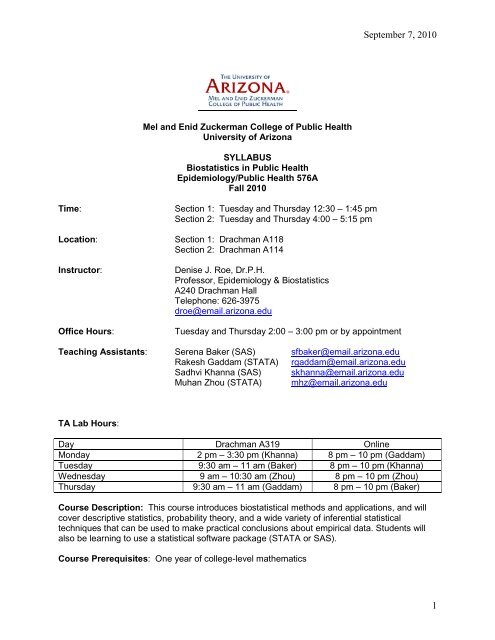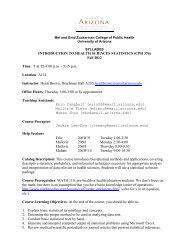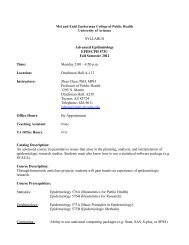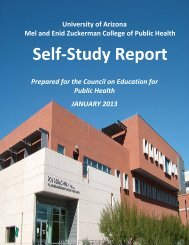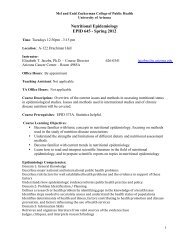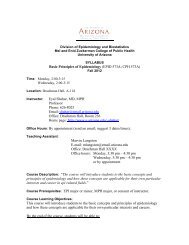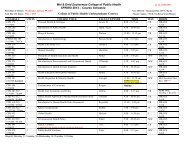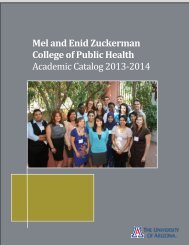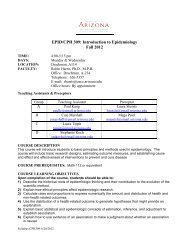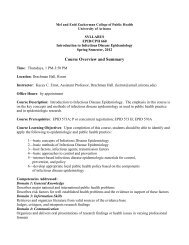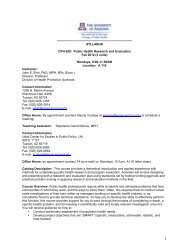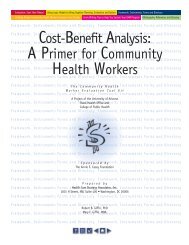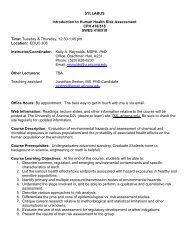CPH 576A Biostatistics for Public Health - Mel and Enid Zuckerman ...
CPH 576A Biostatistics for Public Health - Mel and Enid Zuckerman ...
CPH 576A Biostatistics for Public Health - Mel and Enid Zuckerman ...
Create successful ePaper yourself
Turn your PDF publications into a flip-book with our unique Google optimized e-Paper software.
September 7, 2010<br />
<strong>Mel</strong> <strong>and</strong> <strong>Enid</strong> <strong>Zuckerman</strong> College of <strong>Public</strong> <strong>Health</strong><br />
University of Arizona<br />
SYLLABUS<br />
<strong>Biostatistics</strong> in <strong>Public</strong> <strong>Health</strong><br />
Epidemiology/<strong>Public</strong> <strong>Health</strong> <strong>576A</strong><br />
Fall 2010<br />
Time:<br />
Location:<br />
Instructor:<br />
Office Hours:<br />
Section 1: Tuesday <strong>and</strong> Thursday 12:30 – 1:45 pm<br />
Section 2: Tuesday <strong>and</strong> Thursday 4:00 – 5:15 pm<br />
Section 1: Drachman A118<br />
Section 2: Drachman A114<br />
Denise J. Roe, Dr.P.H.<br />
Professor, Epidemiology & <strong>Biostatistics</strong><br />
A240 Drachman Hall<br />
Telephone: 626-3975<br />
droe@email.arizona.edu<br />
Tuesday <strong>and</strong> Thursday 2:00 – 3:00 pm or by appointment<br />
Teaching Assistants: Serena Baker (SAS) sfbaker@email.arizona.edu<br />
Rakesh Gaddam (STATA) rgaddam@email.arizona.edu<br />
Sadhvi Khanna (SAS) skhanna@email.arizona.edu<br />
Muhan Zhou (STATA) mhz@email.arizona.edu<br />
TA Lab Hours:<br />
Day Drachman A319 Online<br />
Monday 2 pm – 3:30 pm (Khanna) 8 pm – 10 pm (Gaddam)<br />
Tuesday 9:30 am – 11 am (Baker) 8 pm – 10 pm (Khanna)<br />
Wednesday 9 am – 10:30 am (Zhou) 8 pm – 10 pm (Zhou)<br />
Thursday 9:30 am – 11 am (Gaddam) 8 pm – 10 pm (Baker)<br />
Course Description: This course introduces biostatistical methods <strong>and</strong> applications, <strong>and</strong> will<br />
cover descriptive statistics, probability theory, <strong>and</strong> a wide variety of inferential statistical<br />
techniques that can be used to make practical conclusions about empirical data. Students will<br />
also be learning to use a statistical software package (STATA or SAS).<br />
Course Prerequisites: One year of college-level mathematics<br />
1
September 7, 2010<br />
Course Learning Objectives: At the end of the course, you should be able to:<br />
1. Identify the properties of given data sets, including the level of measurement <strong>for</strong> each<br />
variable.<br />
2. Apply appropriate descriptive statistics to the data according to its measurement type.<br />
3. Apply appropriate inferential statistics to the data according to its measurement type.<br />
4. Formulate <strong>and</strong> test hypotheses.<br />
5. Use a computer statistical software package (Stata or SAS) to accomplish objectives 2 - 4.<br />
6. Apply your statistical knowledge to the design of research studies, including selection of<br />
proper research design <strong>and</strong> determination of sample sizes necessary to show statistical<br />
significance<br />
7. Interpret <strong>and</strong> critique medical <strong>and</strong> scientific journal articles which frequently rely heavily on<br />
statistical procedures.<br />
Course Notes: A webpage has been created <strong>for</strong> this class using the Desire 2 Learn (D2L)<br />
interface. The course website contains the syllabus, class notes, homework assignments,<br />
STATA do-files, datasets (used in lecture <strong>and</strong> <strong>for</strong> the homework) <strong>and</strong> readings.<br />
Class announcements also will be posted on this site, so it is a good idea to check the site<br />
be<strong>for</strong>e each class to stay current.<br />
To access the <strong>576A</strong> website, login at: http://d2l.arizona.edu/index.asp<br />
Click the ‘UA NetID’ Login.<br />
Enter your NetID <strong>and</strong> password, as you would to access your UA email account.<br />
Under ‘My Courses’, click on: ‘<strong>CPH</strong> EPID<strong>576A</strong> FA10 001-911 Roe’<br />
o News: This section contains any class announcements, such as changes in the<br />
homework schedule, etc.<br />
o Content: Access the syllabus, class notes, homework assignments <strong>and</strong><br />
supplemental in<strong>for</strong>mation in this section.<br />
For further in<strong>for</strong>mation on how to use the D2L interface, go to:<br />
http://www.help.d2l.arizona.edu/tip_sheet<br />
Note that D2L has a separate email system. Please remember to check it regularly.<br />
Alternatively you can configure it to <strong>for</strong>ward your D2L email to your UA email account. The<br />
instructions are found at: http://help.d2l.arizona.edu/students/email#auto<strong>for</strong>ward<br />
Note that if you do not have a UA NetID, please see me so that I can give you access to the<br />
D2L site.<br />
Required Text: Principles of <strong>Biostatistics</strong> Second Edition, Marcello Pagano <strong>and</strong> Kimberlee<br />
Gauvreau, Duxbury Press, Pacific Grove, CA, 2000<br />
The text is available in the Medical School Bookstore. It comes with a CD that has data sets <strong>for</strong><br />
use in homework problems. The data sets used in the homework are not in the chapter<br />
directories, but rather can be found in the exercise directory. A copy of the text can be checked<br />
out from Anita Foley (206 FF).<br />
2
September 7, 2010<br />
Course Requirements:<br />
1. Read the text<br />
Please bring questions about the text with you to the lecture<br />
2. Homework<br />
The homework due date is noted on the syllabus.<br />
Late homework assignments will not be accepted. Homework must be turned in during<br />
class on the due date, or by 5pm in the bin outside my office door. Electronic <strong>and</strong> faxed<br />
submissions will not be accepted unless prior arrangements have been made (e.g., due to<br />
travel to conferences, illness, etc.).<br />
Scoring: Each part of the question is worth one point. For example, question 16 with three<br />
parts (a, b, c) is worth 3 points.<br />
Format: Please put the ‘by h<strong>and</strong>” problems first, <strong>and</strong> then the ‘Stata or SAS” problems<br />
second. The ‘by h<strong>and</strong>’ homework can be typed or h<strong>and</strong>written. Circle or highlight numeric<br />
answers that you calculate by h<strong>and</strong>. Remember to show your work so that the Grader knows<br />
that you just did not copy the answer from the answer key. Bold, highlight, or otherwise<br />
emphasize those results that are obtained as computer output. Note, too, that sometimes<br />
you have to do a problem both by h<strong>and</strong> <strong>and</strong> in Stata or SAS – those cases are not typos.<br />
Staple your homework answers. Remember to put your name <strong>and</strong> your section number on<br />
the front page at least.<br />
Do each homework problem be<strong>for</strong>e consulting the answer key<br />
Answers are posted on the D2L website – it is your responsibility to check your homework<br />
against the answer key to ensure that the answer is correct<br />
Homework is checked <strong>for</strong> completeness only. Full credit if you try the homework even if you<br />
don’t get the correct answer.<br />
Keep copies of all of your homework so that you can study <strong>for</strong> the exams while your<br />
submitted work is being graded by the Grader.<br />
You can drop your lowest two homework scores. It is best to reserve these <strong>for</strong> times that you<br />
are unexpectedly out of town, cannot turn in the homework due to illness, or your computer<br />
crashes with your homework on it.<br />
3. Analysis Papers<br />
Three analysis papers are meant to give you an opportunity to integrate the pieces that you<br />
have learned throughout the course<br />
For each paper, you will be referred to a data set <strong>and</strong> given a hypothesis to test<br />
The <strong>for</strong>mat is specified in the D2L site<br />
Late analysis papers will not be accepted. They must be turned in during class on the due<br />
date, or by 5pm in the bin outside my office door. Electronic <strong>and</strong> faxed submissions will not<br />
be accepted unless prior arrangements have been made (e.g., due to travel to conferences,<br />
illness, etc.).<br />
4. Examinations<br />
Two midterm exams<br />
A <strong>for</strong>mula sheet <strong>for</strong> each exam is available on D2L <strong>and</strong> will be distributed with the exam.<br />
Practice exams with the correct answers are available using questions that have appeared on<br />
previous exams<br />
Please in<strong>for</strong>m me ASAP if you are unable to take an exam on the scheduled exam date.<br />
3
September 7, 2010<br />
5. Final Project<br />
The final project is meant to give you an opportunity to show that you underst<strong>and</strong> the<br />
scientific method <strong>and</strong> the role of biostatistics in answering a scientific question<br />
Students will select one paper from a list of papers on the D2L site <strong>and</strong> answer questions<br />
related to that paper<br />
The papers <strong>and</strong> <strong>for</strong>mat will be specified in the D2L site after the second midterm exam<br />
The final project must be turned in no later than the start of the scheduled final exam <strong>for</strong> your<br />
section. It may be turned in as early as the last day of class, but may not be turned in later<br />
than the start of your scheduled final exam. Electronic <strong>and</strong> faxed submissions will not be<br />
accepted unless prior arrangements have been made (e.g., due to travel to conferences,<br />
illness, etc.).<br />
Grading/Student Evaluation: Homework, analysis papers, examinations <strong>and</strong> the final project<br />
contribute to your final grade as follows:<br />
Homework<br />
10% (each chapter weighted the same, even if length differs)<br />
Analysis Papers 15% (5% each)<br />
Two Exams 50% (25% each)<br />
Final Project 25%<br />
Final grades are based on the following point system:<br />
A = 90-100%<br />
B = 80-89%<br />
C = 70-79%<br />
D = 60-69%<br />
E = 59% or less<br />
Grades will not be curved. The instructor reserves the right to revise this scale, if necessary.<br />
Class Attendance/Participation: Class attendance is strongly encouraged, but not required.<br />
If a student misses class, they are responsible <strong>for</strong> meeting all course deadlines, <strong>and</strong> <strong>for</strong> working<br />
with other students, the TAs <strong>and</strong> the instructor (during office hours) to catch up. All holidays or<br />
special events observed by organized religions will be honored <strong>for</strong> those students who show<br />
affiliation with that particular religion. Absences pre-approved by the UA Dean of Students (or<br />
Dean’s designee will be honored.)<br />
Course Schedule: Any changes to the following schedule will be announced in lecture. You<br />
are responsible <strong>for</strong> obtaining in<strong>for</strong>mation on any changes, even if you miss class.<br />
4
September 7, 2010<br />
Date Topic<br />
Homework by<br />
P&G Reading H<strong>and</strong><br />
Stata or SAS<br />
Homework<br />
HW<br />
Due Date<br />
8/24, 8/26 Data Types <strong>and</strong><br />
Chs. 1-2 2: 1-7, 16a 2: 8, 16b-c, 17-19 8/31<br />
Presentation<br />
8/31, 9/2 Numerical Summary Ch. 3 3: 1-3, 7 3: 7, 12 (not 12b), 9/7<br />
Measures<br />
(skip 3.3, 3.4)<br />
13, 15<br />
9/7, 9/9 Probability Ch. 6 (skip 6: 1-5, 7-9, 13-15 9/14<br />
6.5)<br />
9/14, 9/16 Probability Distributions Ch. 7 7: 1-3, 6-10, 13<br />
9/21<br />
(skip 7.3) (not 13c), 17-18<br />
9/21 Sampling Distributions Ch. 8 8: 1-6, 8, 11, 13 9/28<br />
9/23 Confidence Intervals Ch. 9 9: 1-5, 8 9: 8, 10, 12, 13 9/30<br />
9/28 Review<br />
9/30 Exam 1 Ch. 2,3,6-9<br />
10/5, 10/7, Hypothesis Testing Ch. 10 10: 1-9, 14, 15 10: 10, 11, 16 10/19<br />
10/12<br />
10/14 Comparison of Two Means Ch. 11 11: 1-4 11: 5-6, 9-10, 13 10/21<br />
10/19, Analysis of Variance Ch. 12 12: 1-6 12: 10, 11, h<strong>and</strong>out 10/28<br />
10/21<br />
10/26 Nonparametric Methods Ch. 13 13: 1-5 13: 8, 10, 11, 13-14 11/2<br />
Analysis Paper 1 11/4<br />
10/28, 11/2 Relative Risk & Odds Ratio,<br />
Contingency Tables<br />
11/4 Review<br />
Ch. 6.5, 15 6: 18, 19<br />
15:1-6<br />
15: 8-10, 14, 19-20 11/9<br />
11/9 Exam 2 Ch. 6.5, 10-<br />
13, 15<br />
Analysis Paper 2 11/16<br />
11/16 Correlation Ch. 17 17:1-4 17:5-6 11/23<br />
11/18,<br />
11/23<br />
Regression Ch. 18 18:1-7 18:10-13 11/30<br />
Analysis Paper 3 12/2<br />
11/30, 12/2 Multiple Regression Ch. 19 19:1-7 19:8-11 12/7<br />
12/7 Review<br />
Final Project Due<br />
Section 1: 12/16, 11 am<br />
Section 2: 12/14, 5 pm<br />
5
September 7, 2010<br />
Computer Labs: Stata <strong>and</strong> SAS are available <strong>for</strong> public use at two locations:<br />
Drachman Hall Computing Lab: Drachman A319, open weekdays, from 8-5.<br />
There are printers available free of charge if you want to print homework, etc, but you must<br />
supply your own paper.<br />
Arizona <strong>Health</strong> Sciences Library Computer Lab: AHSC 2150, open every day 6am-midnight.<br />
These computers are behind the in<strong>for</strong>mation/reference desk on the main floor. The first couple<br />
of banks of machines is not part of the lab, but is rather used <strong>for</strong> lit searching, etc. The lab is<br />
the ‘walled off’ section of computers behind the first couple of banks. You may print output here<br />
at the rate of 10 cents per page <strong>for</strong> black <strong>and</strong> white <strong>and</strong> 75 cents per page <strong>for</strong> color. Note that<br />
these are public facilities, <strong>and</strong> may or may not be crowded on a given day.<br />
Students must register to use the AHSC Library Computer Lab at the Library In<strong>for</strong>mation Desk.<br />
A University of Arizona Catcard is required.<br />
Purchasing STATA or SAS:<br />
STATA: You can order online at the following link:<br />
http://stata.com/order/new/edu/gradplans/gp-campus.html. STATA/IC 11 is available in the<br />
classroom <strong>and</strong> labs. It is appropriate <strong>for</strong> virtually all analyses except <strong>for</strong> very large datasets with<br />
an extremely large number of variables. STATA 11/IC can be ordered at an academic rate of<br />
$98.00 <strong>for</strong> a one-year license <strong>and</strong> $179 <strong>for</strong> a perpetual license. Be sure to mention that you are<br />
ordering from the GRADPLAN. Purchases can be picked up at the U of A BookStore on the<br />
lower level.<br />
Basic manuals are available at the lab locations, <strong>and</strong> a Stata version 10 set (which is fine <strong>for</strong><br />
what we’ll be doing in this class) will be available in the Epidemiology/<strong>Biostatistics</strong> library on the<br />
2 nd floor of Drachman Hall. Moreover, there is reasonable electronic help with the package, so<br />
you won’t need the basic manuals unless you are working at home <strong>and</strong>/or want to continue with<br />
the package long-term. If you want to borrow a manual from the library, check it out with Anita<br />
Foley.<br />
SAS: SAS can be ordered from the U of A BookStore. The cost is $79 per year. The link with<br />
the necessary in<strong>for</strong>mation is:<br />
http://www.uofabookstores.com/uaz/CATS/License_SAS.asp.<br />
6
September 7, 2010<br />
Tips <strong>for</strong> Succeeding in the Course:<br />
1. Attend class<br />
2. Find a study group<br />
3. Get to know one of the TAs<br />
4. Read the textbook be<strong>for</strong>e coming to class<br />
5. Ask questions about the reading in class<br />
6. Do your homework early<br />
7. Check your homework answers against the answer key<br />
8. Turn your homework, Analysis Papers <strong>and</strong> Final Project in on time<br />
9. Ask questions until you underst<strong>and</strong> the material<br />
Communications: You are responsible <strong>for</strong> reading emails sent to your UA account from your<br />
professor <strong>and</strong> the announcements that are placed on the course web site. In<strong>for</strong>mation about<br />
readings, news events, your grades, assignments <strong>and</strong> other course related topics will be<br />
communicated to you with these electronic methods. The official policy can be found at:<br />
http://www.registrar.arizona.edu/emailpolicy.htm<br />
Disability Accommodation: If you anticipate issues related to the <strong>for</strong>mat or requirements of<br />
this course, please meet with me. I would like us to discuss ways to ensure your full<br />
participation in the course. If you determine that <strong>for</strong>mal, disability-related accommodations are<br />
necessary, it is very important that you be registered with Disability Resources (621-3268;<br />
http://drc.arizona.edu/) <strong>and</strong> notify me of your eligibility <strong>for</strong> reasonable accommodations. We can<br />
then plan how best to coordinate your accommodations. The official policy can be found at:<br />
http://catalog.arizona.edu/2009-10/policies/disability.htm<br />
Academic Integrity: All students are expected to do their own work. For homework, feel free<br />
to ask each other questions about concepts <strong>and</strong> procedures. However, when it comes time to<br />
write down the homework to turn in, do that on your own. Duplicate homework will be<br />
considered a breach of academic integrity. Likewise, <strong>for</strong> the Analysis Papers, feel free to ask<br />
each other questions <strong>and</strong> discuss ideas, but the actual analysis <strong>and</strong> report generation needs to<br />
be your own work. No communication between students of any sort is allowed during exams or<br />
regarding the Final Project.<br />
All UA students are responsible <strong>for</strong> upholding the University of Arizona Code of Academic<br />
Integrity, available through the office of the Dean of Students <strong>and</strong> online: The official policy<br />
found is at: http://catalog.arizona.edu/policies/974/acacode.htm<br />
Classroom Behavior: Students are expected to be respectful of the instructor <strong>and</strong> other<br />
students at all times (including limited talking, no reading newspapers, etc.). Cell phones may<br />
be brought to class but should be in the mute or vibrate position. If you must take an<br />
emergency call or page during class please leave class quietly to speak with the caller (do not<br />
leave <strong>and</strong> return more than once as this disrupts the rest of the class). Students may use their<br />
laptops during class only <strong>for</strong> course related material.<br />
Students are expected to be familiar with the UA Policy on Disruptive Behavior in an<br />
Instructional Setting found at http://web.arizona.edu/~policy/disruptive.pdf<br />
<strong>and</strong> the Policy on Threatening Behavior by Students found at:<br />
http://web.arizona.edu/~policy/threatening.pdf<br />
7
September 7, 2010<br />
Grievance Policy: Should a student feel he or she has been treated unfairly, there are a<br />
number of resources available. With few exceptions, students should first attempt to resolve<br />
difficulties in<strong>for</strong>mally by bringing those concerns directly to the person responsible <strong>for</strong> the action,<br />
or with the student's graduate advisor, Assistant Dean <strong>for</strong> Student <strong>and</strong> Alumni Affairs,<br />
department head, or the immediate supervisor of the person responsible <strong>for</strong> the action. If the<br />
problem cannot be resolved in<strong>for</strong>mally, the student may file a <strong>for</strong>mal grievance using the<br />
Graduate College Grievance Policy found at:<br />
http://grad.arizona.edu/academics/policies/academic-policies/grievance-policy<br />
Grade Appeal Policy: http://catalog.arizona.edu/2009-10/policies/gradappeal.htm<br />
Syllabus Changes: In<strong>for</strong>mation contained in the course syllabus, other than the grade <strong>and</strong><br />
absence policies, may be subject to change with reasonable advance notice, as deemed<br />
appropriate. The examination dates will not change but the material to be tested may change.<br />
Plagiarism: What counts as plagiarism<br />
Copying <strong>and</strong> pasting in<strong>for</strong>mation from a web site or another source, <strong>and</strong> then revising it so<br />
that it sounds like your original idea.<br />
Doing an assignment/essay/take home test with a friend <strong>and</strong> then h<strong>and</strong>ing in separate<br />
assignments that contain the same ideas, language, phrases, etc.<br />
Quoting a passage without quotation marks or citations, so that it looks like your own.<br />
Paraphrasing a passage without citing it, so that it looks like your own.<br />
Hiring another person to do your work <strong>for</strong> you, or purchasing a paper through any of the onor<br />
off-line sources.<br />
8


